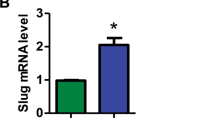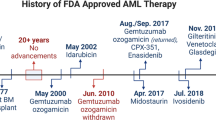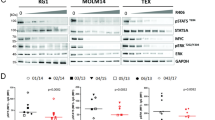Abstract
Acute myeloid leukemia (AML) is a clinically and molecularly heterogeneous neoplasia with poor outcome, organized as a hierarchy initiated and maintained by a sub-population with differentiation and self-renewal capacities called leukemia stem cells (LSCs). Although currently used chemotherapy is capable of initially reducing the tumor burden producing a complete remission, most patients will ultimately relapse and will succumb to their disease. As such, new therapeutic strategies are needed. AML cells differentially expressed serotonin receptor type 1 (HTR1) compared with healthy blood cells and the most primitive hematopoietic fraction; in fact, HTR1B expression on AML patient samples correlated with clinical outcome. Inhibition of HTR1s activated the apoptosis program, induced differentiation and reduced the clonogenic capacity, while minimal effect was observed on healthy blood cells. In vivo regeneration capacity of primary AML samples was disrupted upon inhibition of HTR1. The self-renewal capacity remaining in AML cells upon in vivo treatment was severely reduced as demonstrated by serial transplantation. Thus, treatment with HTR1 antagonists showed antileukemia effect, especially anti-LSC activity while sparing healthy blood cells. Our results highlight the importance of HTR1 in leukemogenesis and LSC survival and identify this receptor family as a new target for therapy in AML with prognostic value.
This is a preview of subscription content, access via your institution
Access options
Subscribe to this journal
Receive 12 print issues and online access
$259.00 per year
only $21.58 per issue
Buy this article
- Purchase on Springer Link
- Instant access to full article PDF
Prices may be subject to local taxes which are calculated during checkout







Similar content being viewed by others
References
Dohner H, Estey EH, Amadori S, Appelbaum FR, Buchner T, Burnett AK et al. Diagnosis and management of acute myeloid leukemia in adults: recommendations from an international expert panel, on behalf of the European LeukemiaNet. Blood 2010; 115: 453–474.
Bonnet D, Dick JE . Human acute myeloid leukemia is organized as a hierarchy that originates from a primitive hematopoietic cell. Nat Med 1997; 3: 730–737.
Gentles AJ, Plevritis SK, Majeti R, Alizadeh AA . Association of a leukemic stem cell gene expression signature with clinical outcomes in acute myeloid leukemia. JAMA 2010; 304: 2706–2715.
Eppert K, Takenaka K, Lechman ER, Waldron L, Nilsson B, van Galen P et al. Stem cell gene expression programs influence clinical outcome in human leukemia. Nat Med 2011; 17: 1086–1093.
Ishikawa F, Yoshida S, Saito Y, Hijikata A, Kitamura H, Tanaka S et al. Chemotherapy-resistant human AML stem cells home to and engraft within the bone-marrow endosteal region. Nat Biotechnol 2007; 25: 1315–1321.
Estey EH . Acute myeloid leukemia: 2013 update on risk-stratification and management. Am J Hematol 2013; 88: 318–327.
Peters MA, Walenkamp AM, Kema IP, Meijer C, de Vries EG, Oosting SF . Dopamine and serotonin regulate tumor behavior by affecting angiogenesis. Drug Resist Updat 2014; 17: 96–104.
Sachlos E, Risueno RM, Laronde S, Shapovalova Z, Lee JH, Russell J et al. Identification of drugs including a dopamine receptor antagonist that selectively target cancer stem cells. Cell 2012; 149: 1284–1297.
Hannon J, Hoyer D . Molecular biology of 5-HT receptors. Behav Brain Res 2008; 195: 198–213.
Vicentini LM, Cattaneo MG, Fesce R . Evidence for receptor subtype cross-talk in the mitogenic action of serotonin on human small-cell lung carcinoma cells. Eur J Pharmacol 1996; 318: 497–504.
Siddiqui EJ, Shabbir M, Mikhailidis DP, Thompson CS, Mumtaz FH . The role of serotonin (5-hydroxytryptamine1A and 1B) receptors in prostate cancer cell proliferation. J Urol 2006; 176 (Part 1): 1648–1653.
Siddiqui EJ, Shabbir MA, Mikhailidis DP, Mumtaz FH, Thompson CS . The effect of serotonin and serotonin antagonists on bladder cancer cell proliferation. BJU Int 2006; 97: 634–639.
Alpini G, Invernizzi P, Gaudio E, Venter J, Kopriva S, Bernuzzi F et al. Serotonin metabolism is dysregulated in cholangiocarcinoma, which has implications for tumor growth. Cancer Res 2008; 68: 9184–9193.
Huhnt W, Lubbe AS . Venules and arterioles in xenotransplanted human colon adenocarcinoma critically constrict with hyperthermia and serotonin. J Cancer Res Clin Oncol 1995; 121: 267–274.
Huhnt W, Lubbe AS . Growth, microvessel density and tumor cell invasion of human colon adenocarcinoma under repeated treatment with hyperthermia and serotonin. J Cancer Res Clin Oncol 1995; 121: 423–428.
Stucker O, Vicaut E, Teisseire B . Specific response to 5-HT2 agonists by arterioles linked to Meth A tumors in mice. Am J Physiol 1992; 262 (Part 2): H704–H709.
Moreno-Martinez D, Nomdedeu M, Lara-Castillo MC, Etxabe A, Pratcorona M, Tesi N et al. XIAP inhibitors induce differentiation and impair clonogenic capacity of acute myeloid leukemia stem cells. Oncotarget 2014; 5: 4337–4346.
Feniuk W, Humphrey PP, Perren MJ, Watts AD . A comparison of 5-hydroxytryptamine receptors mediating contraction in rabbit aorta and dog saphenous vein: evidence for different receptor types obtained by use of selective agonists and antagonists. Br J Pharmacol 1985; 86: 697–704.
Ireland SJ, Tyers MB . Pharmacological characterization of 5-hydroxytryptamine-induced depolarization of the rat isolated vagus nerve. Br J Pharmacol 1987; 90: 229–238.
Schuurkes JA, Van Nueten JM, Van Daele PG, Reyntjens AJ, Janssen PA . Motor-stimulating properties of cisapride on isolated gastrointestinal preparations of the guinea pig. J Pharmacol Exp Ther 1985; 234: 775–783.
Millan MJ, Maiofiss L, Cussac D, Audinot V, Boutin JA, Newman-Tancredi A . Differential actions of antiparkinson agents at multiple classes of monoaminergic receptor. I. A multivariate analysis of the binding profiles of 14 drugs at 21 native and cloned human receptor subtypes. J Pharmacol Exp Ther 2002; 303: 791–804.
Monachon MA, Burkard WP, Jalfre M, Haefely W . Blockade of central 5-hydroxytryptamine receptors by methiothepin. Naunyn Schmiedebergs Arch Pharmacol 1972; 274: 192–197.
Turvill JL, Connor P, Farthing MJ . The inhibition of cholera toxin-induced 5-HT release by the 5-HT(3) receptor antagonist, granisetron, in the rat. Br J Pharmacol 2000; 130: 1031–1036.
Gale JD, Grossman CJ, Whitehead JW, Oxford AW, Bunce KT, Humphrey PP . GR113808: a novel, selective antagonist with high affinity at the 5-HT4 receptor. Br J Pharmacol 1994; 111: 332–338.
Glennon RA, Naiman NA, Pierson ME, Titeler M, Lyon RA, Weisberg E . NAN-190: an arylpiperazine analog that antagonizes the stimulus effects of the 5-HT1A agonist 8-hydroxy-2-(di-n-propylamino)tetralin (8-OH-DPAT). Eur J Pharmacol 1988; 154: 339–341.
Selkirk JV, Scott C, Ho M, Burton MJ, Watson J, Gaster LM et al. SB-224289—a novel selective (human) 5-HT1B receptor antagonist with negative intrinsic activity. Br J Pharmacol 1998; 125: 202–208.
Price GW, Burton MJ, Collin LJ, Duckworth M, Gaster L, Gothert M et al. SB-216641 and BRL-15572—compounds to pharmacologically discriminate h5-HT1B and h5-HT1D receptors. Naunyn Schmiedebergs Arch Pharmacol 1997; 356: 312–320.
Arvidsson LE, Hacksell U, Glennon RA . Recent advances in central 5-hydroxytryptamine receptor agonists and antagonists. Prog Drug Res 1986; 30: 365–471.
Connor HE, Feniuk W, Humphrey PP, Perren MJ . 5-Carboxamidotryptamine is a selective agonist at 5-hydroxytryptamine receptors mediating vasodilatation and tachycardia in anaesthetized cats. Br J Pharmacol 1986; 87: 417–426.
Linder S, Shoshan MC . Is translational research compatible with preclinical publication strategies? Radiat Oncol 2006; 1: 4.
Zhang DE, Hetherington CJ, Gonzalez DA, Chen HM, Tenen DG . Regulation of CD14 expression during monocytic differentiation induced with 1 alpha,25-dihydroxyvitamin D3. J Immunol 1994; 153: 3276–3284.
Prudovsky I, Popov K, Akimov S, Serov S, Zelenin A, Meinhardt G et al. Antisense CD11b integrin inhibits the development of a differentiated monocyte/macrophage phenotype in human leukemia cells. Eur J Cell Biol 2002; 81: 36–42.
Hoyer D, Hannon JP, Martin GR . Molecular, pharmacological and functional diversity of 5-HT receptors. Pharmacol Biochem Behav 2002; 71: 533–554.
Xu Q, Simpson SE, Scialla TJ, Bagg A, Carroll M . Survival of acute myeloid leukemia cells requires PI3 kinase activation. Blood 2003; 102: 972–980.
Grandage VL, Gale RE, Linch DC, Khwaja A . PI3-kinase/Akt is constitutively active in primary acute myeloid leukaemia cells and regulates survival and chemoresistance via NF-kappaB, Mapkinase and p53 pathways. Leukemia 2005; 19: 586–594.
Stauffer F, Holzer P, Garcia-Echeverria C . Blocking the PI3K/PKB pathway in tumor cells. Curr Med Chem Anticancer Agents 2005; 5: 449–462.
Min YH, Eom JI, Cheong JW, Maeng HO, Kim JY, Jeung HK et al. Constitutive phosphorylation of Akt/PKB protein in acute myeloid leukemia: its significance as a prognostic variable. Leukemia 2003; 17: 995–997.
Schmidt MJ, Sawyer BD, Perry KW, Fuller RW, Foreman MM, Ghetti B . Dopamine deficiency in the weaver mutant mouse. J Neurosci 1982; 2: 376–380.
Ginawi OT, Al-Majed AA, Al-Suwailem AK, El-Hadiyah TM . Involvement of some 5-HT receptors in methamphetamine-induced locomotor activity in mice. J Physiol Pharmacol 2004; 55: 357–369.
Walpole SC, Prieto-Merino D, Edwards P, Cleland J, Stevens G, Roberts I . The weight of nations: an estimation of adult human biomass. BMC Public Health 2012; 12: 439.
Carter BZ, Qiu Y, Huang X, Diao L, Zhang N, Coombes KR et al. Survivin is highly expressed in CD34(+)38(−) leukemic stem/progenitor cells and predicts poor clinical outcomes in AML. Blood 2012; 120: 173–180.
Fukuda S, Abe M, Onishi C, Taketani T, Purevsuren J, Yamaguchi S et al. Survivin selectively modulates genes deregulated in human leukemia stem cells. J Oncol 2011; 2011: 946936.
Wagner M, Schmelz K, Wuchter C, Ludwig WD, Dorken B, Tamm I . In vivo expression of survivin and its splice variant survivin-2B: impact on clinical outcome in acute myeloid leukemia. Int J Cancer 2006; 119: 1291–1297.
Pauwels PJ, Gouble A, Wurch T . Activation of constitutive 5-hydroxytryptamine(1B) receptor by a series of mutations in the BBXXB motif: positioning of the third intracellular loop distal junction and its G(o)alpha protein interactions. Biochem J 1999; 343 (Part 2): 435–442.
Hu Y, Li S . Survival regulation of leukemia stem cells. Cell Mol Life Sci 2016; 73: 1039–1050.
Cornet-Masana JM, Moreno-Martinez D, Lara-Castillo MC, Nomdedeu M, Etxabe A, Tesi N et al. Emetine induces chemosensitivity and reduces clonogenicity of acute myeloid leukemia cells. Oncotarget 2016; 7: 23239–23250.
Flasshove M, Strumberg D, Ayscue L, Mitchell BS, Tirier C, Heit W et al. Structural analysis of the deoxycytidine kinase gene in patients with acute myeloid leukemia and resistance to cytosine arabinoside. Leukemia 1994; 8: 780–785.
Galmarini CM, Thomas X, Calvo F, Rousselot P, Rabilloud M, El Jaffari A et al. In vivo mechanisms of resistance to cytarabine in acute myeloid leukaemia. Br J Haematol 2002; 117: 860–868.
Zhang Y, Chen HX, Zhou SY, Wang SX, Zheng K, Xu DD et al. Sp1 and c-Myc modulate drug resistance of leukemia stem cells by regulating survivin expression through the ERK-MSK MAPK signaling pathway. Mol Cancer 2015; 14: 56.
Berenbaum MC . Criteria for analyzing interactions between biologically active agents. Adv Cancer Res 1981; 35: 269–335.
Chou TC, Talalay P . Quantitative analysis of dose–effect relationships: the combined effects of multiple drugs or enzyme inhibitors. Adv Enzyme Regul 1984; 22: 27–55.
Pulte D, Gondos A, Brenner H . Expected long-term survival of patients diagnosed with acute myeloblastic leukemia during 2006-2010. Ann Oncol 2010; 21: 335–341.
Dizeyi N, Bjartell A, Nilsson E, Hansson J, Gadaleanu V, Cross N et al. Expression of serotonin receptors and role of serotonin in human prostate cancer tissue and cell lines. Prostate 2004; 59: 328–336.
Soll C, Jang JH, Riener MO, Moritz W, Wild PJ, Graf R et al. Serotonin promotes tumor growth in human hepatocellular cancer. Hepatology 2010; 51: 1244–1254.
New DC, Wong YH . Molecular mechanisms mediating the G protein-coupled receptor regulation of cell cycle progression. J Mol Signal 2007; 2: 2.
Charan J, Kantharia ND . How to calculate sample size in animal studies? J Pharmacol Pharmacother 2013; 4: 303–306.
Acknowledgements
We thank Marta Bistagne for her administrative support and all members of the Risueño laboratory for helpful discussions. RMR is supported by Ramón y Cajal program of the Spanish Ministry of Economy (RYC-2011-07998), AE holds a contrato predoctoral para la formación de doctores fellowship (BES-2013-066388), and MN and MAT are supported by Premi Fi de Residència Emili Letang of Hospital Clínic. This work was supported by the Plan Nacional SAF2012-34352 (to RMR), AECC-JP Barcelona (to RMR), the Josep Carreras International Leukaemia Foundation (to RMR), l’Obra Social 'La Caixa'-Fundació Bancària 'La Caixa' (to RMR), RETICC RD12/0036/0010 (to JE and RMR) and FIS PI13/00999 (to JE).
Author contributions
AE, MCL-C, JMC-M, AB-M and MN: acquisition of data, analysis and interpretation of data, and revision of the manuscript; MP, MAT, MD-B and JE: revision of the manuscript and material support; RMR: conception and design, acquisition of data, analysis and interpretation of data and writing the manuscript.
Author information
Authors and Affiliations
Corresponding author
Ethics declarations
Competing interests
The results presented in this paper have been patented. RMR is a shareholder of Leukos Biotech.
Additional information
Supplementary Information accompanies this paper on the Leukemia website
Supplementary information
Rights and permissions
About this article
Cite this article
Etxabe, A., Lara-Castillo, M., Cornet-Masana, J. et al. Inhibition of serotonin receptor type 1 in acute myeloid leukemia impairs leukemia stem cell functionality: a promising novel therapeutic target. Leukemia 31, 2288–2302 (2017). https://doi.org/10.1038/leu.2017.52
Received:
Revised:
Accepted:
Published:
Issue Date:
DOI: https://doi.org/10.1038/leu.2017.52
This article is cited by
-
Prolactin receptor signaling induces acquisition of chemoresistance and reduces clonogenicity in acute myeloid leukemia
Cancer Cell International (2023)
-
Influence on therapeutic outcome of platelet count at diagnosis in patients with de novo non-APL acute myeloid leukemia
BMC Cancer (2023)
-
Meta-analysis of gene signatures and key pathways indicates suppression of JNK pathway as a regulator of chemo-resistance in AML
Scientific Reports (2021)
-
Repurposing the serotonin agonist Tegaserod as an anticancer agent in melanoma: molecular mechanisms and clinical implications
Journal of Experimental & Clinical Cancer Research (2020)
-
Chlorpromazine eliminates acute myeloid leukemia cells by perturbing subcellular localization of FLT3-ITD and KIT-D816V
Nature Communications (2020)



